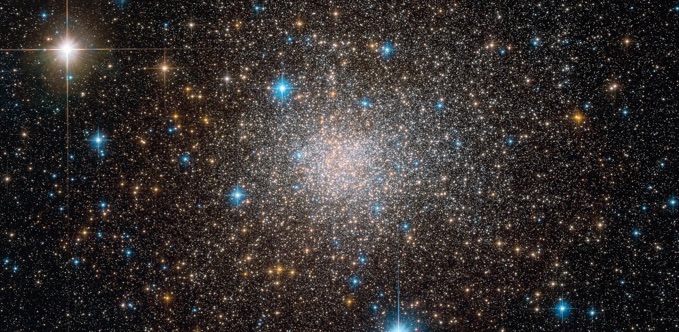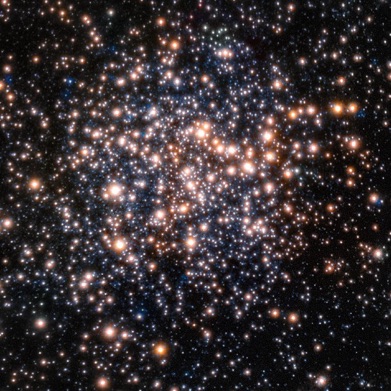ASTRO-ARCHAEOLOGY:
a rare fossil of the early Milky Way
An international team of astronomers has discovered that a fossil remnant of the early Milky Way harbours stars of hugely different ages. This stellar system, named as Terzan 5, is located in the heart of our galaxy (the Bulge) and has the appearance of a globular cluster, but it is like no other star cluster known. It contains stars remarkably similar to the most ancient ones in the Milky Way, but it also hosts a significant population of much younger objects. Hence Terzan 5 could be a site in the Galactic Bulge where recent star formation occurred. This is the fascinating conclusion reached by the international team of astronomers led by Francesco Ferraro of the Physics and Astronomy Department of the Bologna University (Italy), and published in the September 6, 2016 issue of the prestigious Astrophysical Journal. The discovery arises from an unprecedented synergy among the three most powerful telescopes in the world: the Hubble Space Telescope, the Very Large Telescope and the W. M. Keck Observatory.
For any additional information please contact
Francesco Ferraro
email: francesco.ferraro3@unibo.it
tel: +390512095774
mobile: +393666357560


Somehow Terzan 5 has managed to survive total disruption for billions of years, and has been preserved as a remnant of the distant past of the Milky Way. "The discovery rises a number of intriguing questions: How Terzan 5 survived the destruction? Which event triggered its second burst of star formation? We are currently searching for the answers to these questions", adds R. Michael Rich from the University of California Los Angeles, who coordinated the observations at the Keck Telescope
"We are now performing an extensive search for other complex stellar systems possibly still hidden in the Bulge: the discovery of other remnants with properties similar to those of Terzan 5 would provide a solid proof that the dissolution/merging of massive clumps has been an important process in the formation of the Galactic Bulge", adds Livia Origlia (INAF-Bologna).
Its unusual properties make Terzan 5 the ideal candidate for being a living fossil from the early days of the Milky Way history: current models of galaxy bulge formation assume that vast clumps of gas and stars interacted to form the primordial Bulge of the Milky Way, merging and dissolving in the process.
"We think that some remnants of these gaseous clumps could remain undisrupted and keep existing embedded within the Galaxy", explains Ferraro. "Such galactic fossils allow astronomers to reconstruct an important piece of history of our Milky Way. In fact, like archaeologists who dig through the dust piling up on top of the remains from past civilizations and unearth crucial pieces of the history of mankind, we have unveiled an extraordinary cosmic relic: in fragments like this one it is written the history of the formation of the first cosmic structures (as our Galaxy) at the time when the Universe was a baby, just one-billion year old."
The discovery is the last result obtained within Cosmic-Lab, a 5-year Advanced Grant project funded with 1.8 million euros by the European Research Council, specifically designed to probe the complex dynamical phenomena occurring into the congested regions of dense star clusters. "Thanks to this grant we have grown a team of prepared and motivated researchers, and the results are impressive! This discovery represents a major success for the Italian and the European astrophysical community and suggests that we are on the right track not only to open new perspectives to the astrophysical knowledge, but also to provide a fruitful breeding ground for the formation of young scientists with a broad view in Physics and Astrophysics. This project has contributed to create a top-level research centre for stellar Astrophysics at the Bologna University, that will be a reference for young students, not only in Italy, but also in Europe and all over the world", concludes Ferraro.
While the properties of Terzan 5 have never been observed in any globular cluster, they are very similar to those of the stars tightly packed in the central region of the Milky Way, the Galactic Bulge. These similarities could make Terzan 5 a fossil relic of the Galaxy formation epoch, one of the earliest building blocks of the Bulge of the Milky Way.
This assumption is strengthened by the mass that Terzan 5 must have had originally to create two stellar populations: a mass similar to that of the huge clumps that are assumed to have generated the Milky Way Bulge about 12 billion years ago.
"Indeed a few characteristics of Terzan 5 closely resemble those of the giant clumps observed in star-forming galaxies at high-redshift, thus suggesting that similar assembling processes occurred in the local and in the distant Universe at the epoch of the Galaxy formation", continues Ferraro.
Thus, this discovery paves the way for a better and more complete understanding of galaxy assembly. "Terzan 5 could represent an intriguing link between the local and the distant Universe, a survived witness of the Galactic Bulge assembly process", explains Ferraro while commenting on the importance of the discovery.
The research presents a possible route for astronomers to unravel the mysteries of galaxy formation, and offers an unrivaled view into the complicated history of the Milky Way.
"Only another globular cluster-like stellar system with such a complex history of star formation has been observed up to now in the halo of the Milky Way: omega Centauri. This is the first time that we see something similar in the Bulge", says the team member Emanuele Dalessandro (INAF-Bologna). The dominant stellar population in omega Centauri is quite metal-poor (a few cents of the solar metallicity) and this object could therefore be the remnant of a stellar system that was accreted by the Galaxy during its evolution. Instead, in the case of Terzan 5 the scenario seems to be quite different, since the oldest stellar population has the same high metallicity (half solar) of the stars in the Bulge. This suggests that the Bulge could have formed from the progressive disruption of many Terzan5-like objects.



The four ESO-VLT 8.2 meter telescopes on Cerro Paranal in the Atacama desert (Chile).
The two 10-meter telescopes of the W.M. Keck Observatory at the top of the Mauna Kea at the Hawaii islands (USA).
MEASURING STELLAR AGES IN TERZAN 5
"Only thanks to an unprecedented combination of HST and adaptive optics-assisted ground-based images, we have been able to construct a superb colour-magnitude diagram where the two populations harboured in Terzan 5 appear clearly distinguishable, thus allowing the accurate measures of their ages", says the team member Barbara Lanzoni (UniBO).
The ages of the two stellar populations in Terzan 5 are remarkably different: the old stellar component dates back to 12 Gyr ago. This means that Terzan5 formed at the very beginning of the Milky Way history, when the Universe was just 1 Gyr-old. The young generation is only 4.5 Gyr-old, meaning that it has the same age of the Earth.
"It was just amazing to find such a large age difference between the two populations. However, this finding is fully consistent with the predictions of canonical self-enrichment evolution models: the chemical abundances and the ages measured both suggest that the younger generation has formed from a metal-enriched gas, polluted by the supernova explosions of the first population", adds team member Alessio Mucciarelli (UniBO).
The accurate measure of the age of a stellar population requires the construction of high-quality colour-magnitude diagrams, where the luminosity of stars is plotted as a function of their colour (a quantity that depends on the temperature).
Colour-magnitude diagram of Terzan 5. Each dot corresponds to a star with magnitude and colour (temperature) readable along the y-axis and x-axis, respectively. The blue and red lines mark the predictions of stellar models with ages of 12 and 4.5 Gyr, respectively. Clearly, the 12 Gyr model is unable to reproduce the stars observed at magnitude ~16-17, and the 4.5 Gyr model is needed to account for their presence in the system.
Astronomers found compelling evidence that there are two distinct kinds of stars in Terzan 5, which not only differ in their chemical composition, but also show an age-gap of roughly 7 billion years. The discovery has been obtained by combining observations performed with the Hubble Space Telescope (Advanced Camera for Surveys and Wide Field Camera 3), and two of the most powerful ground-based telescopes: the Very Large Telescope (VLT) dell`European Southern Observatory (ESO) and the W.M. Keck Observatory (USA), equipped with adaptive-optics facilties (MAD@VLT and NIRC2@Keck) able to compensate for the distortion that terrestrial atmosphere produces on astronomical images.
"Back in 2009 we discovered that Terzan 5 harboured two sub-populations of stars with different chemical abundances. After 7 years of research we finally succeeded in dating these populations", explains Francesco Ferraro from the University of Bologna (UniBO), lead author of the study.
Two spectacular views of Terzan 5. The picture on the left has been shot in the I-band by the HST. It covers the central 40"x40" region of Terzan 5 and it is oriented with North to the top and East to the left. The image on the right has been obtained at the VLT in the near infrared, and it is slightly more zoomed-in than the other.
The ages of the two populations indicate that the star formation process in Terzan 5 was not continuous, but dominated by two distinct main bursts. The observations confirm that, as expected from the stellar evolution theory, the younger (second-generation) component has formed from metal-enriched gas, polluted by the supernova explosions of the first stellar population. "This requires the ancestor of Terzan5 to have large amounts of gas for a second generation of stars to form. It also must have been quite massive, at least 100 million times the mass of the Sun", explains Davide Massari, co-author of the study from INAF-Bologna (Italy) and from the University of Groningen (The Netherlands).
Terzan 5, at 19 000 light-years from Earth, in the Bulge of our galaxy, has been classified as a globular cluster for forty-odd years since its detection. Now, an Italian-led team of astronomers has discovered that it is like no other globular clusters known.


Credit: NASA/ESA/Hubble/F. R. Ferraro



